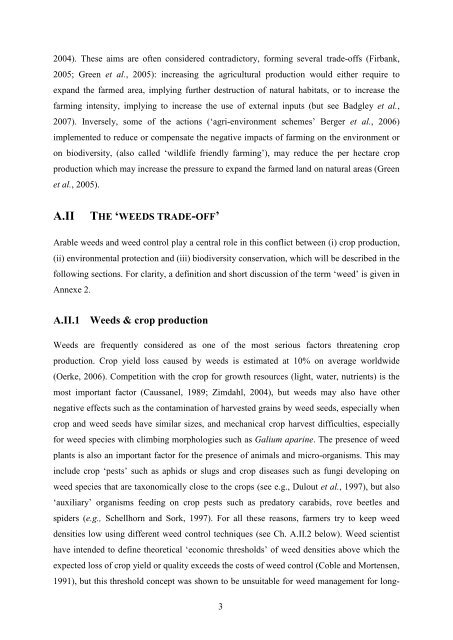Diversifying crop rotations with temporary grasslands - Université de ...
Diversifying crop rotations with temporary grasslands - Université de ...
Diversifying crop rotations with temporary grasslands - Université de ...
Create successful ePaper yourself
Turn your PDF publications into a flip-book with our unique Google optimized e-Paper software.
2004). These aims are often consi<strong>de</strong>red contradictory, forming several tra<strong>de</strong>-offs (Firbank,<br />
2005; Green et al., 2005): increasing the agricultural production would either require to<br />
expand the farmed area, implying further <strong>de</strong>struction of natural habitats, or to increase the<br />
farming intensity, implying to increase the use of external inputs (but see Badgley et al.,<br />
2007). Inversely, some of the actions (‘agri-environment schemes’ Berger et al., 2006)<br />
implemented to reduce or compensate the negative impacts of farming on the environment or<br />
on biodiversity, (also called ‘wildlife friendly farming’), may reduce the per hectare <strong>crop</strong><br />
production which may increase the pressure to expand the farmed land on natural areas (Green<br />
et al., 2005).<br />
A.II THE ‘WEEDS TRADE-OFF’<br />
Arable weeds and weed control play a central role in this conflict between (i) <strong>crop</strong> production,<br />
(ii) environmental protection and (iii) biodiversity conservation, which will be <strong>de</strong>scribed in the<br />
following sections. For clarity, a <strong>de</strong>finition and short discussion of the term ‘weed’ is given in<br />
Annexe 2.<br />
A.II.1 Weeds & <strong>crop</strong> production<br />
Weeds are frequently consi<strong>de</strong>red as one of the most serious factors threatening <strong>crop</strong><br />
production. Crop yield loss caused by weeds is estimated at 10% on average worldwi<strong>de</strong><br />
(Oerke, 2006). Competition <strong>with</strong> the <strong>crop</strong> for growth resources (light, water, nutrients) is the<br />
most important factor (Caussanel, 1989; Zimdahl, 2004), but weeds may also have other<br />
negative effects such as the contamination of harvested grains by weed seeds, especially when<br />
<strong>crop</strong> and weed seeds have similar sizes, and mechanical <strong>crop</strong> harvest difficulties, especially<br />
for weed species <strong>with</strong> climbing morphologies such as Galium aparine. The presence of weed<br />
plants is also an important factor for the presence of animals and micro-organisms. This may<br />
inclu<strong>de</strong> <strong>crop</strong> ‘pests’ such as aphids or slugs and <strong>crop</strong> diseases such as fungi <strong>de</strong>veloping on<br />
weed species that are taxonomically close to the <strong>crop</strong>s (see e.g., Dulout et al., 1997), but also<br />
‘auxiliary’ organisms feeding on <strong>crop</strong> pests such as predatory carabids, rove beetles and<br />
spi<strong>de</strong>rs (e.g., Schellhorn and Sork, 1997). For all these reasons, farmers try to keep weed<br />
<strong>de</strong>nsities low using different weed control techniques (see Ch. A.II.2 below). Weed scientist<br />
have inten<strong>de</strong>d to <strong>de</strong>fine theoretical ‘economic thresholds’ of weed <strong>de</strong>nsities above which the<br />
expected loss of <strong>crop</strong> yield or quality exceeds the costs of weed control (Coble and Mortensen,<br />
1991), but this threshold concept was shown to be unsuitable for weed management for long-<br />
3

















